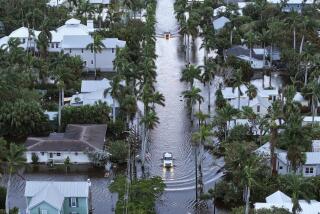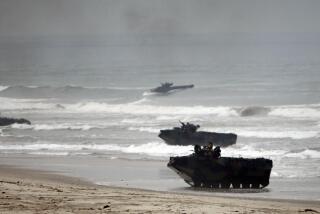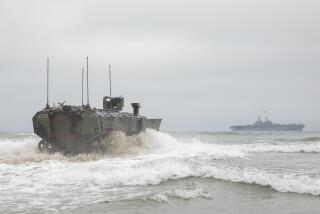Searchers Wade Into the Thick of It
- Share via
NEW ORLEANS — After 11 days holed up in his flooded home, Earl Cephus finally gave up Thursday morning. A police officer escorted Cephus from his second-floor redoubt -- not into the arms of the law but into the belly of a Marine Corps assault amphibian vehicle.
When Cephus mentioned that his family didn’t know whether he was dead or alive, a Marine battalion commander whipped out a satellite phone. Within minutes, he had Cephus’ sister-in-law on the line from Chicago.
“We’ve got Earl right here -- he’s alive and well,” Lt. Col. Kent Ralston told the woman. “He was crazy and thought he could ride this thing out.”
“Oh, Earl!” Ralston heard her say. “He’s alive!”
Ralston handed the phone to Cephus, who recoiled as his sister-in-law berated him for refusing to leave home for so long.
The ruined home of Earl Cephus was one stop among dozens for a Marine rescue team that floated through the roiling lake that is now New Orleans East. Chugging through the foul waters, often at treetop level, their amphibious vehicles, known as Amtracs, brought them to the second-story balconies of some of the most inaccessible homes in this submerged city.
On their third day navigating oily black floodwaters, the Marines, with city police officers aboard, removed Cephus, a mechanic, and Rico Lewis, a truck driver, from homes. They also rescued Lewis’ dog King, two parakeets, an abandoned Rottweiler puppy and a cockatiel.
It was part of a citywide rescue-and-recovery effort involving thousands of people, including police, firefighters, soldiers and Marines. Eleven days after New Orleans was inundated with floodwaters, holdouts are still surviving on stockpiled food.
Marine crews said they expected to find more residents, and possibly bodies, when they ventured into unexplored neighborhoods today.
“I got plenty of food saved up,” said Cephus, a lanky man with a pencil mustache and impeccably groomed hair. “I could’ve stuck it out a lot longer. I didn’t want to go. They made me go.”
Lewis, a stocky truck driver wearing a T-shirt and red cap, was reluctant to leave when police and Marines spotted him in his waterlogged doorway, enjoying a cup of soup. Told he had to evacuate, Lewis protested but finally asked, “Can I take my dog?”
King, affectionately called a “mixed-breed mutt” by Lewis, was hauled aboard the Amtrac with his owner.
The Marines are particularly suited for search and rescue because their 48-ton Amtracs are military versions of vehicles invented in the 1930s to rescue people from hurricanes and floods. Floodwaters in many sections of New Orleans East -- one of the worst-hit areas of the city -- are too high for standard vehicles and too low or debris-clogged for many boats.
In shallow water, the Amtracs’ treads clanked along the pavement Thursday, cutting through the muck. In neighborhoods where the water was as deep as 7 feet, the vehicles floated and surged, producing powerful wakes that slapped against homes, ripping doors from their hinges.
Several times, the vehicles lurched as they crunched over the tops of submerged cars, producing a loud, grinding noise. Debris surged through the greenish-black waters -- freezers, belly-up fish, palm trees and pickup trucks.
Ralston’s battalion, a mixture of active-duty and Reserve Marines from Camp Lejeune, N.C., and Tampa, Fla., has rescued nearly 50 people in the last three days, using 13 Amtracs. Some of the areas they flowed through Thursday had been searched by other crews, the houses marked in orange paint with the date and unit. But others had not been searched at all.
“I think we’re down to the hard-core holdouts by now,” Ralston said.
On one Amtrac, three police officers climbed onto balconies and through attic windows, looking for signs of life. Two of them had lost their own homes in the flooding, which they said made the search-and-rescue effort all the more meaningful.
“It feels good to help, no matter what happened to me,” said T.V. Tran, a Vietnamese American policeman who got a good look at his badly flooded home from his post in the Amtrac’s open troop compartment. The Amtracs were plowing through Village de l’Est, also known as Little Saigon, which is 80% Vietnamese American.
As he spotted homes of people he knew, Tran shouted out their names and pleaded in Vietnamese for them to come to the windows. He was greeted with silence. He suspected some of his neighbors were holding out, either to protect their homes or because they were afraid of being evacuated to a relief center in a strange place.
Another officer, Patrick Hartman, is homeless, sleeping at a different location every night. Since the flooding, he said, he has been left with virtually nothing. He was wearing a soiled, sweaty T-shirt.
At one house, Hartman spotted a red flag tied to the roof -- a distress signal. The Amtrac pulled up, and he crawled onto the roof. He found a second distress signal: a white T-shirt with the message, “We need help.”
But a search of the house produced nothing, and the officers suspected the person in the house had already been rescued. Hartman saved the shirt.
“It’s cleaner than the one I have,” he said.
At one point, the Amtrac came across a 2 1/2 -ton military truck marooned in high water, its wheels mired in the muck. In the truck bed were Greg Terrill and Chuck Mills, a pair of swift-water rescue firefighters from Sherman Oaks. Wearing yellow waders, they had been hopping off the truck and walking through the filthy waters to search homes when the vehicle got stuck.
The Marines hooked up a towline, gunned the Amtrac engine, and the truck was yanked up out of the water and sent on its way.
The Amtrac crews ended up finding more animals than people. They discovered a dog drowned in a bathtub on Biscay Street, apparently after he fell in while trying to drink from water left in the tub. They discovered a pair of parakeets near Beaucaire Street and filled their water container and set the cage on the balcony with a supply of bird food left by the owners.
Just off Dwyer Road, they encountered an agitated cockatiel, which fluttered madly through a second-story apartment before Hartman and fellow officer Mike Duzmar captured the bird and set it free.
It was hot, dirty, demanding work. The Marines sweated beneath their body armor and helmets, squinting in the harsh sunlight as they scanned the second floors for signs of life. Their faces and their arms were sunburned in the open compartment, and they guzzled bottle after bottle of water. For eight hours, they breathed in the hot exhaust fumes belched out by the Amtrac engines, cranking away at 3 to 4 miles to the gallon.
Later, Col. John Shook, deputy commander for Marines in the area, ordered the men to check one another for open cuts; he told them a firefighter’s leg had been amputated after he let a minor sore fester.
Health authorities have warned of infection from the polluted floodwaters, and the thrust of the Amtracs sent up a thin spray that sprinkled the faces of those on board.
The hot afternoon wore on, and the men wore down. The Amtracs rumbled and floated, guided by street signs that protruded from the waves. The vehicles pulled abreast of house after house, and the weary officers clambered onto balconies and walkways. At one apartment, they smashed open a patio door to get inside.
As the vehicles approached a flooded Comfort Suites Inn, its parking lot clogged with submerged cars, the Marines noticed that the American flag out front was drooping in the filthy water.
“Got to save our colors,” said Staff Sgt. Joshua Luneall. Marines and police officers lay on their bellies, stretching to retrieve the flag. They fished it out and managed to reattach it to the pole.
Someone slowly raised the flag. For the first time that day, everyone aboard fell silent.
More to Read
Sign up for Essential California
The most important California stories and recommendations in your inbox every morning.
You may occasionally receive promotional content from the Los Angeles Times.











